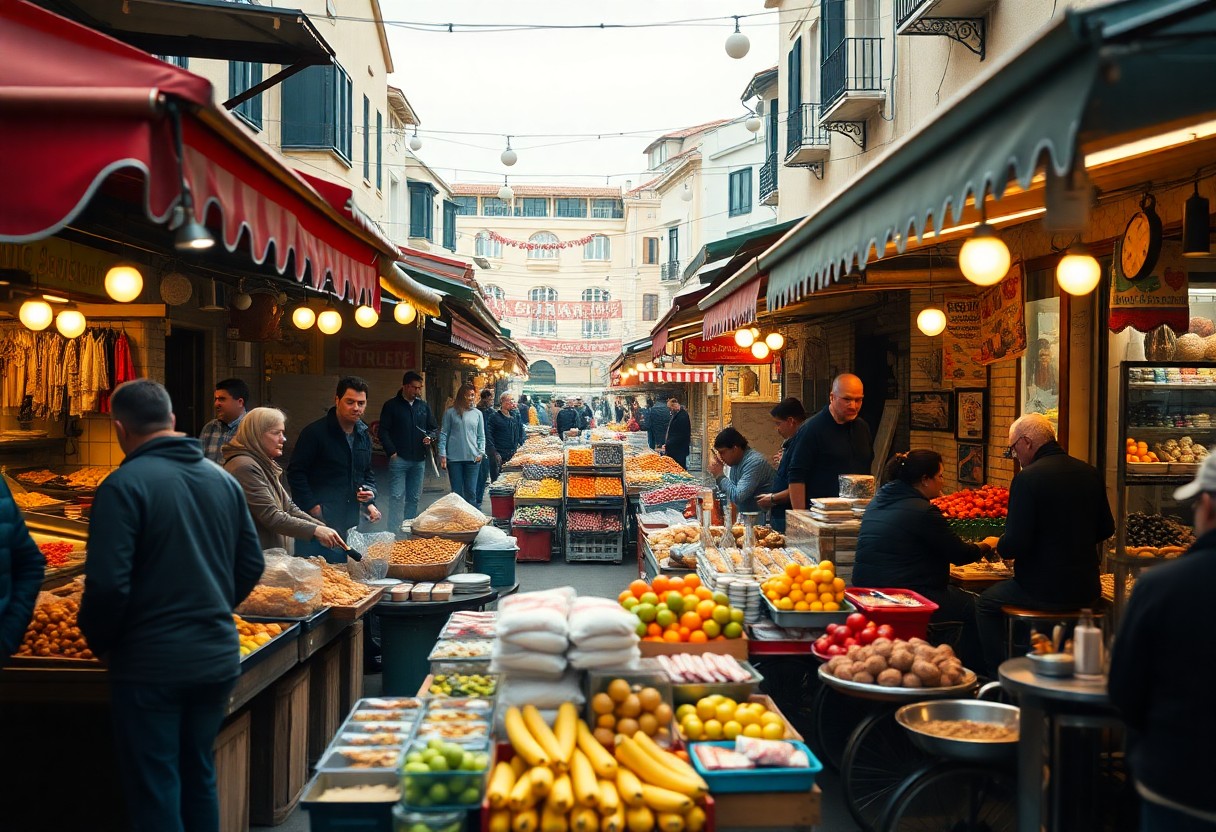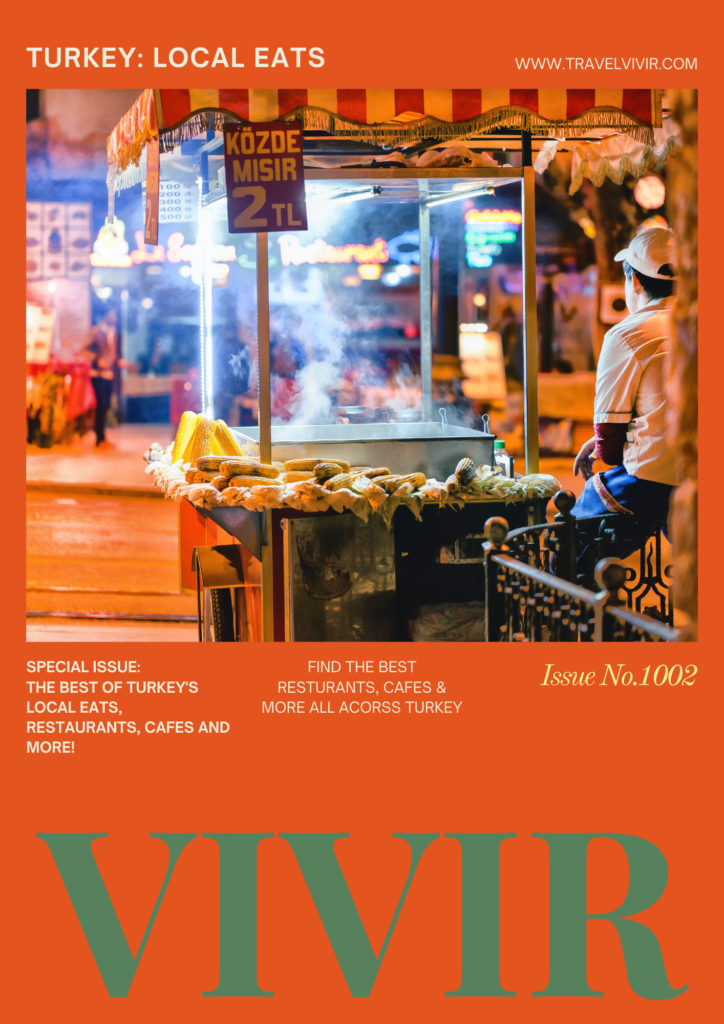There’s a vibrant world of Turkey’s local eats just waiting for you to discover. Filled with culinary treasures that showcase the rich flavors of the region. From bustling street food stalls to cozy cafés and exquisite restaurants, you will find an array of dishes that tantalize your taste buds. This guide will steer you toward the best spots to enjoy Turkey’s local eats, ensuring your gastronomic adventure is both satisfying and enjoyable. For an in-depth experience, check out A FOODIE GUIDE: WHERE TO EAT IN ISTANBUL.
Turkey’s Local Eats Key Takeaways:
- Exploration of Turkey’s Local Eats: Discover the vibrant array of culinary delights that embody the essence of Turkey’s local eats, offering a tantalizing fusion of flavors and ingredients unique to each region.
- Cafes, Restaurants, and Street Food: Turkey’s local eats are best experienced in its diverse cafes and restaurants, where traditional recipes are celebrated, as well as through lively street food scenes that provide authentic and quick bites to satisfy your cravings.
- Cultural Richness: Engage your taste buds in the cultural richness of Turkey’s local eats, which reflect the country’s history and heritage, ensuring a culinary adventure that connects you to the heart of Turkish traditions.

Types of Local Eats in Turkey
A culinary adventure through Turkey isn’t complete without exploring its diverse array of local eats. You will find an impressive selection of dishes across the country, each rich in flavor and history. Turkish cuisine beautifully showcases a blend of influences from various regions, resulting in satisfying meals that tempt your taste buds. Here are a few main categories of local eats that you should explore:
| Traditional Turkish Cuisine | Classic dishes rooted in history, featuring rich flavors and ingredients. |
| Street Food Delights | Quick, affordable, and full of flavor, these bites reflect the hustle of urban life. |
| Regional Specialties | Unique dishes indigenous to specific areas, showcasing the geographical diversity. |
| Gourmet Dining Experiences | High-end meals emphasizing local ingredients and artistic presentation. |
| Vegetarian Options | Delicious meat-free dishes perfect for those seeking lighter fare. |
Any exploration of Turkey’s local eats must begin with the roots of its traditional cuisine. Featuring staples like kebabs, meze, and manti, these dishes are imbued with flavors from the Ottoman culinary legacy. Traditional meats, vegetables, and legumes are typically employed in rich, aromatic dishes that are served with side dishes full of herbs and spices. Enjoying a meal at a local restaurant can feel like participating in a time-honored ritual that transcends continents and generations.
As you investigate deeper, you’ll discover that each region of Turkey boasts its unique culinary treasures. Allowing you to taste the varying influences of coastal, mountainous, and urban environments. Famous for its baklava and pide, Turkey’s local eats meld tradition with creativity. From the bustling bazaars of Istanbul to the tranquil towns along the coast, your palate will thank you.
Street Food Delights
You can’t truly grasp Turkey’s local eats without sampling its vibrant street food culture. Streets are lined with vendors offering an exciting array of quick bites that are both rich in flavor and history. Popular options, like kumpir (stuffed baked potatoes) and midye dolma (stuffed mussels), reflect the country’s maritime bounty and creativity in food presentation. These dishes provide an affordable and satisfying way to sample local flavors while on the move.
A stroll through the lively streets will introduce you to the tantalizing scents of grilled meats, spiced pastries, and traditional sweets. You’ll find simit and döner kebab enticing you around almost every corner. Making them unmissable stops on your culinary journey. With Turkish street food, immerse yourself in the rhythm of the city and savor the authenticity of local life.
Gourmet Dining Experiences
Assuming you’re looking for something more upscale, Turkey offers a range of gourmet dining experiences where you can indulge in high-quality interpretations of traditional dishes. Several fine dining establishments focus on presenting locally sourced ingredients prepared with innovative techniques. This culinary approach elevates Turkey’s local eats, showcasing delicate flavors in ways that surprise and delight your palate.
From Michelin-starred establishments to acclaimed chefs crafting seasonal tasting menus, gourmet dining in Turkey offers a journey of diverse flavors, textures, and artistic presentations. Cuisine in these settings often embraces sustainability, championing local farmers and producers committed to quality. Your dining experience can thus blend tasting with a sense of purpose, celebrating the rich cultural heritage while pushing culinary boundaries.

Essential Tips for Food Exploration
Even as you launch on your culinary journey through Turkey’s Local Eats, there are crucial tips. First, embrace the variety. Turkish cuisine offers a vast array of dishes, from the rich flavors of Mantı to the delightful crunch of Baklava. Second, explore the local markets where you can find fresh ingredients like spices. Lastly, be open to trying new things; don’t hesitate to sample meze or venture into regional specialties that differ from the typical tourist offerings.
- Explore: Make time to visit local markets and neighborhoods for authentic eats.
- Taste: Don’t hesitate to order a variety of dishes; sharing is a common practice.
- Engage: Chat with locals or vendors to learn about the foods you’re sampling.
Any exploration of Turkey’s local eats should also involve understanding the regional elements that influence culinary traditions. By immersing yourself in Turkey’s gastronomy, you will undoubtedly create lasting memories around the dining table.
Best Times to Visit for Turkey’s Local Eats
Times to visit Turkey for the best culinary experiences vary by season. Spring (March to June) and autumn (September to November) are ideal as the weather is pleasant, and local farmers’ markets are brimming with fresh produce. During these months, you can find seasonal ingredients that enhance the flavors of traditional dishes, making it the perfect time to taste authentic Turkish eats. Additionally, many festivals and culinary events occur during these seasons, offering you unique opportunities to engage with local flavors.
Summer months, while hot, also have their perks with seaside towns bursting with an array of fresh seafood options like Balık Ekmek. However, winter can be a challenging time if you’re looking for street food as many vendors close during colder periods. Overall, planning your visit around these seasons can ensure that you experience the best of Turkey’s local eats.
How to Navigate Local Markets
On your adventures in Turkey, you’ll quickly find that local markets are a treasure trove of flavors and experiences. To navigate these vibrant spaces effectively, start by familiarizing yourself with common local products and dishes. Approach the vendors with curiosity and a willingness to taste; they often provide samples, allowing you to get acquainted with authentic Turkish flavors. Learning a few basic Turkish phrases can also go a long way in connecting with the vendors and making your experience more immersive.
Visit the local markets early in the day for the freshest selections of fruits, vegetables, and spices, all key components of Turkey’s local eats. Engaging with vendors will not only help you choose the best ingredients but also provide an avenue to learn about the culinary traditions that shape their offerings. Don’t shy away from bargaining, as it is part of the traditional shopping experience in Turkey.
Etiquette and Dining Customs
For those dining in Turkey, understanding local etiquette can enrich your experience. A few customs to keep in mind include waiting for the host to start the meal before you begin eating and being considerate of your surroundings during mealtime. It’s customary to remove your shoes when entering a home, and when eating out, sharing plates is popular, emphasizing the communal aspect of Turkish dining. Toasting with your drink before sipping is also a significant tradition, especially highlighting local brews and raki.
It’s crucial to show appreciation for the host’s efforts, as hospitality is a cornerstone of Turkish culture. Complimenting the meal and expressing your enjoyment can foster goodwill and pave the way for deeper connections. Additionally, tipping around 10% in restaurants is appreciated, although service charges are often included in the bill. By observing these customs, you’ll make a lasting impression while enjoying Turkey’s local eats.
Step-by-Step Guide to Tasting Local Flavors
For a truly unforgettable experience, stepping into Turkey’s local eats requires more than just an adventurous palate; you need a plan to navigate through the rich tapestry of flavors that Turkish cuisine has to offer. This culinary journey is not only about tasting dishes but embracing the culture that surrounds them. By understanding the local dining etiquette, being aware of regional specialties, and knowing where to find authentic flavors, you’ll have a memorable gastronomic adventure.
| Aspect | Detail |
| Regional Varieties | Explore different regions like Istanbul for street food or Cappadocia for testi kebab. |
| Dining Etiquette | Learn local customs, such as sharing meze dishes and using bread to scoop food. |
| Timing | Dine at local taverns to experience meals at their freshest and most authentic. |
| Language | Basic Turkish phrases can enhance your interaction with local chefs and staff. |
Planning Your Culinary Journey – Turkey’s local eats
If you want to immerse yourself in Turkey’s local eats, a well-structured plan will enhance your experience. Research the local delicacies specific to each region you visit, as Turkey’s culinary offerings vary dramatically. Make it a priority to sample traditional dishes like mantı and baklava in authentic settings, rather than tourist traps.
Additionally, consider arranging food tours or cooking classes that can provide insider insights. Engaging with local chefs or families will not only teach you how to prepare dishes but also connect you to the rich history behind Turkey’s local eats. This two-fold approach will deepen your appreciation for the flavors you’ll encounter.
Choosing the Right Restaurants and Cafes
Assuming you want to savor the most authentic Turkish cuisine, selecting the right eateries is paramount. Avoiding tourist hotspots will lead you to hidden gems where the locals dine. Look for restaurants that offer a range of traditional dishes, and don’t shy away from asking locals for their recommendations. Read reviews and seek establishments with an emphasis on fresh, locally sourced ingredients, as they tend to deliver the most delicious representations of Turkey’s local eats.
Cafes and small eateries often provide a charming atmosphere that’s just as important as the food itself. These establishments often focus on local delicacies and traditional cooking methods that have been passed down through generations. From cozy cafes serving fresh gözleme to lively restaurants dishing out steaming plates of iskender kebap, every bite can be an adventure.
Sample Itineraries for Food Lovers
Local itineraries designed for food enthusiasts can help you maximize your culinary exploration of Turkey’s diverse food scene. Consider starting your day with a classic Turkish breakfast spread, featuring a medley of cheeses, olives, and fresh bread. Afterward, explore local markets to taste seasonal fruits, spices, and fresh produce. In the afternoon, launch on a culinary walking tour where you can sample regional delicacies, including meze and fresh seafood. Your day should culminate with dinner at a local restaurant where you can indulge in a traditional dish, such as testi kebab.
Food experiences in Turkey can be scattered, but meticulous planning in your itinerary will showcase the best of Turkey’s local eats. Pair your meal with a glass of ayran or a sweet dessert like baklava.
Factors Influencing Food Choices
Despite the variety and richness of Turkey’s local eats, several factors play a significant role in shaping your culinary experiences. From the location and cultural background to personal preferences and dietary restrictions, understanding these influences helps you appreciate the culinary diversity of the region. Here are some key aspects to consider:
- Regional specialties that showcase local ingredients and traditions
- Seasonal availability of ingredients that affect menu options
- Cultural influences that intertwine various gastronomic traditions
- Dietary preferences that guide your choices
Any visit to Turkey invites you to explore THE 10 BEST Restaurants in Istanbul and savor the iconic dishes.
Regional Specialties
The diverse regions of Turkey each boast unique culinary traditions that influence your dining options. For example, coastal areas like the Aegean are known for their fresh seafood, while the inland regions favor hearty meat dishes such as Iskender Kebap. Exploring these regional specialties allows you to enjoy flavors that are not only delicious but also closely tied to the landscape and culture of each area.
When you travel through Turkey, you’ll find that different regions serve variations of familiar dishes. For instance, while you may encounter mantı in many places, each locale may have its twist on the traditional Turkish ravioli, often influenced by local ingredients and cooking methods. This exploration of regional differences is a delightful way to deepen your appreciation for Turkey’s local eats.
Seasonal Ingredients – Turkey’s Local eats
Regional ingredients significantly shape the culinary landscape, particularly regarding seasonal ingredients that change throughout the year. You’ll notice that local markets brim with fresh produce, herbs, and dairy products that reflect the season. Enhancing the flavors and authenticity of your meals. Dishes like Gözleme and Meze can taste vastly different depending on whether they feature summer tomatoes or winter greens.
This commitment to using seasonal ingredients not only supports local farmers but also ensures that you are indulging in the freshest and most flavorful food available. As you wander through bustling bazaars in cities like Istanbul, you can witness the vibrant array of seasonal offerings, which ultimately leads to a more enriched dining experience.
Cultural Influences
Influences from neighboring cuisines have shaped the vibrant tapestry of Turkish gastronomy. As you explore the local food scene, you will find echoes of Mediterranean, Middle Eastern, and Central Asian culinary traditions woven into Turkey’s local eats. Dishes like Lahmacun or Baklava showcase these cultural exchanges and invite you to savor the harmonious blend of flavors.
Specialties like Kumpir illustrate how Turkish cuisine is ever-evolving, often reflecting historical trade routes and cultural interactions. These influences manifest not only in food but also in dining practices, making every meal an opportunity for you to connect with Turkey’s rich and diverse heritage.
Pros and Cons of Dining Out in Turkey
Many travelers find that indulging in Turkey’s local eats is one of the highlights of their journey. However, like any culinary experience, dining out in Turkey comes with its own set of advantages and challenges. Understanding these can help you navigate your dining choices more effectively.
| Pros | Cons |
|---|---|
| Rich culinary heritage with diverse flavors. | Language barriers may hinder communication about menu items. |
| Affordable prices in local eateries. | Quality can vary significantly between establishments. |
| Fresh and local ingredients used in dishes. | Tourist areas may have inflated prices. |
| Exciting street food options available. | Not all food vendors maintain hygiene standards. |
| Social dining culture that encourages sharing. | Longer wait times in popular restaurants. |
| Unique and regional specialties to experience. | Limited vegetarian or vegan options in some areas. |
Advantages of Local Dining – Turkey’s local eats
Advantages of dining out in Turkey include the opportunity to savor authentic flavors that reflect the country’s rich culinary traditions. From the bustling markets of Istanbul to quaint coastal towns, Turkey’s local eats offer a variety of dishes. A feast for both the eyes and the palate. You can enjoy dishes like mantı, small handmade dumplings filled with seasoned meat, or kumpir, a customizable baked potato loaded with toppings.
Furthermore, many local restaurants and street vendors prioritize the use of fresh, seasonal ingredients, ensuring that your meals are both vibrant and nutritious. Eating out becomes not just a necessity, but a way to connect with the rich culture and friendly people of Turkey, where sharing a meal often leads to engaging conversations and warm hospitality.
Challenges to Consider
Any dining experience in Turkey does have its share of challenges. You may encounter language barriers that make it difficult to understand menus or communicate your dietary preferences. Not every restaurant maintains the same level of quality, especially in tourist-heavy areas where inflated prices can sometimes lead to a compromise in taste.
For instance, while indulging in Turkey’s local eats like baklava or iskender kebap can be heavenly, you should also be aware of hygiene standards, particularly at roadside stalls or less formal eateries. It’s beneficial to research and select reputable dining options to ensure a delightful experience.

Notable Cities for Culinary Experiences – Turkey’s Local Eats
Not all places in Turkey offer the same vibrant and diverse culinary experience, but certain cities stand out for their exceptional contributions to Turkey’s local eats. This cultural mosaic is reflected in local dishes, flavors, and dining styles that vary from region to region. Each city has its specialties, making a culinary journey across Turkey an unforgettable adventure, with cities like Istanbul, Gaziantep, and Antalya leading the charge.
Istanbul: The Culinary Capital
There’s no denying that Istanbul serves as the beating heart of Turkey’s gastronomic scene. As a city that bridges Europe and Asia, it showcases a stunning array of flavors. It represents the rich legacy of Ottoman cuisine, along with modern interpretations of traditional dishes. From bustling street stalls serving kumpir (baked potatoes piled high with toppings) to elegant restaurants offering refined versions of iskender kebap, Istanbul presents a unique culinary tapestry.
As you meander through the streets of Istanbul, you’ll uncover the hidden gems. Where the warmth of Turkish hospitality enhances your dining experience. It’s in this vibrant city that you can savor meze, a delightful array of small plates to share, or treat yourself with a piece of baklava. Don’t miss the chance to sip on traditional Turkish tea or coffee as you immerse yourself in the local food culture.
Gaziantep: A Gastronomic Paradise
Any discussion about Turkey’s local eats would be incomplete without mentioning Gaziantep, often celebrated as a gastronomic paradise. This city is renowned for its rich culinary heritage and exceptional use of spices, particularly its famous pistachios and the distinctive flavors of its kebabs. When you visit Gaziantep, you can immerse yourself in the city’s vibrant markets, where the aromas of spices waft through the air.
<p>A visit to Gaziantep means indulging in manti (Turkish dumplings), lovingly prepared by local chefs who have perfected this art over generations. The city’s famed kebab varieties are also a must-try. Often served with lavish sides that complete the meal. Additionally, don’t overlook the wide selection of baklava, with unique regional twists that elevate this classic dessert to new heights.
Antalya: Mediterranean Flavors
While Antalya is primarily known for its stunning beaches and historical sites, it also offers a delightful culinary experience. The coastal city boasts a vibrant food scene where fresh seafood takes center stage, with many local restaurants serving up an impressive array of dishes made from the day’s catch. As you explore Antalya, you’ll be tempted to indulge in locally sourced produce, herbs, and spices that celebrate the Mediterranean climate.
<p>Plus, many dishes feature traditional gözleme, a savory flatbread filled with cheese, spinach, or minced meat, making for a quick and satisfying meal while you enjoy your explorations. You will find charming waterfront restaurants where you can relish these Mediterranean flavors while soaking in the sun and beautiful views. Don’t pass up the opportunity to sample the region’s unique takes on classic Turkish dishes.
Conclusion – Turkey’s Local Eats
<p><p><p>Presently, as you initiate on your culinary adventure through Turkey, you’ll find that the country is a treasure trove of local eats waiting to be explored. From the vibrant street food stalls offering snacks like simit and midye dolma to charming cafes that serve traditional dishes like menemen and gözleme. Every meal is an opportunity to immerse yourself in Turkey’s rich cultural heritage. By indulging in Turkey’s local eats, you’ll experience Turkish hospitality and the artistry of a cuisine.
Similarly, your gastronomic journey can be further enriched by visiting local restaurants and eateries. Whether you’re in the bustling heart of Istanbul or a quaint coastal town. There is always something unique to try. To dive deeper into the culinary scene in Istanbul, check out The Ultimate Istanbul Travel Guide for Food Lovers. This guide will help you navigate through the vibrant food landscape, ensuring that you make the most of your trip!
FAQ
Q: What are some of the must-try dishes when exploring Turkey’s local eats?
A: When delving into Turkey’s local eats, you cannot miss iconic dishes such as Mantı (Turkish Ravioli), Iskender Kebap, and Baklava. Additionally, each region of Turkey offers unique specialties, so be sure to try regional favorites like Kumpir in Istanbul or Testi Kebab in Cappadocia. Don’t forget to sample Meze, which includes various small appetizers, as it provides a wonderful introduction to Turkey’s gastronomic diversity.
Q: Where can I find the best restaurants to enjoy Turkey’s local eats?
A: The best way to experience Turkey’s local eats is to seek out family-owned restaurants, charming cafés, and street food vendors. Areas with bustling markets, such as the Grand Bazaar in Istanbul, often host a range of eateries showcasing authentic Turkish cuisine. Additionally, check local food guides or online reviews to discover hidden gems that locals frequent, ensuring a memorable dining experience.
Q: What types of cafés offer a taste of Turkey’s local eats?
A: In Turkey, cafés are a wonderful spot to enjoy local eats alongside traditional beverages like Turkish tea and coffee. Many cafés serve light snacks and breakfast options, including Gözleme (stuffed flatbreads) and Menemen (scrambled eggs with tomatoes and peppers). Look for cafés situated in vibrant neighborhoods or near historical sites, as they often feature homemade dishes that reflect the heart of Turkey’s local eats.
CHECK OUT ALL OF OUR BLOGS:
Contact us for more information:
Check out our socials and make sure to follow!
www.instagram.com/travel.vivir






